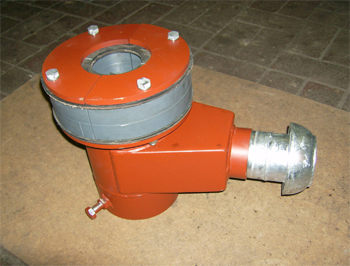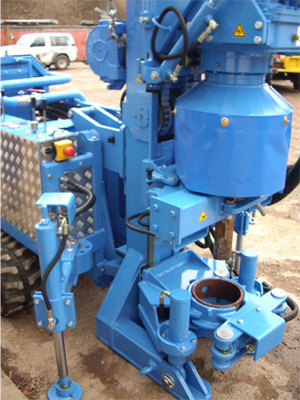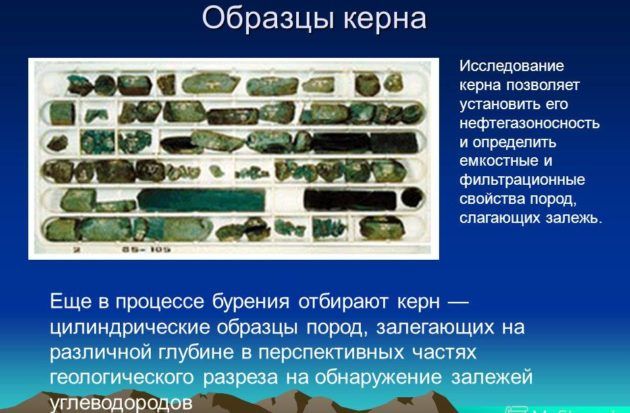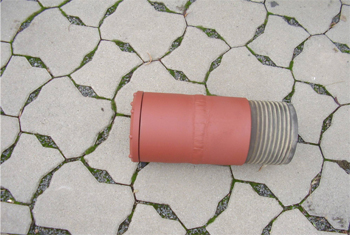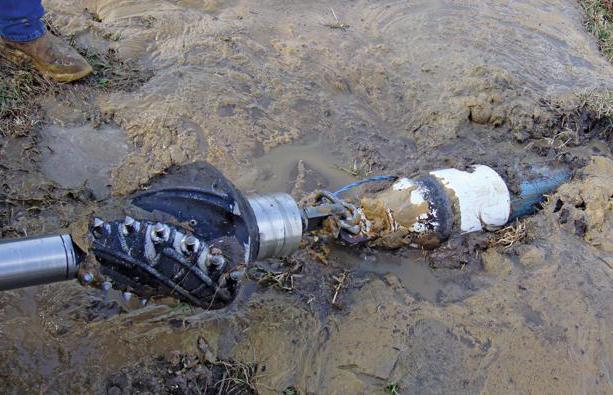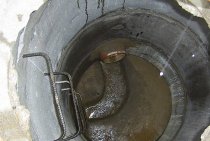Deep well drilling
Drilling a deep well, and especially an ultra-deep one, is a complex and expensive undertaking. In world practice, deep wells are drilled with very powerful and expensive rigs with a lifting capacity of 600-800 tons.
So far, only a few pieces of such installations have been made, fewer than the fingers on one hand.
Our project involves drilling a deep well using a conventional drilling rig.
At the same time, the classical scheme of destruction and removal of rock to the surface of the earth is preserved, but new technological methods are used, some new tools and, most importantly, a new approach to the problem of deep drilling.
The most important element in the complex of equipment is mud pumps, which force drilling (clay) mud under high pressure to circulate down the drill pipes, and then up through the annular gap between the pipe string and the walls of the well.
The energy of the pumps is converted into the useful work of the turbodrill, which rotates the bit at the bottom, and ensures the rise of the drilled rock to the surface of the earth.
The solution leaving the Kola superdeep well is cleaned of rock pieces and re-injected into the drill pipes. The circulation goes on a closed cycle.
If you find yourself on the rig during the rise of the drill string, you will see vertical rows of “candles” inside the derrick – separate pipes into which the string is divided. Usually the column is made up of "candles" 36 meters high. Their diameter is about 15 centimeters.
The bit is worn out - they raise the entire string, screw on a new one and lower the “candles” into the well in the reverse order. When drilling deep wells, the bit makes several hundreds of such trips, and when driving ultra-deep wells - more than a thousand!
At the same time, it is necessary to maintain the verticality of the wellbore within certain tolerances, to fix the exposed rocks in a timely manner with casing pipes, to take rock samples from the bottom - cores, to carry out a complex of downhole geophysical surveys, and many other works.
A deep well drilling rig is, in fact, a large modern plant. The whole complex of equipment is intended to drill a narrow cylindrical passage several kilometers long in the earth's crust. This is just an injection into the bowels of the Earth. But how hard is it to do...
Usually a deep well is started with a large diameter bit. Drilling is carried out until any complications appear in the well (inflow of water, oil and gas, drilling mud drifts, wall collapses), making it impossible to further deepen the well.
Then special pipes are lowered into the shaft, and the space between the pipes and the walls of the well is filled with cement mortar.
Now the well is armored, and drilling can be continued (with bits of a slightly smaller diameter) until any new complications block the path of the bit.
Then another string of pipes is lowered into the well and cemented, with a smaller diameter than the first one. Such pipes are lowered into the well as many as there are zones of complications.
Each deep hole is like an underground telescope, pointing away from the stars. By the number of steps (pipes) in this telescope, the degree of complexity and high cost of drilling is judged.
It is very difficult to determine in advance the required number of telescope links and the ratio of their sizes. It is practically impossible to predict at what depth a complication will occur that will require the casing string, the next link of the telescope, to be lowered into the well.
The subsoil is very variable: literally adjacent wells can differ from each other in terms of drilling conditions.Either suddenly you will encounter a pressure aquifer, from which you should protect yourself with casing pipes, then you will come across a layer of fractured rocks, and the drilling fluid will begin to flow along them instead of carrying the destroyed rock upwards, then suddenly the walls of the well will begin to collapse, then caverns will form ...
It is impossible to foresee all the difficulties on the future underground route. Going on a trip, astronauts probably know more about their routes than drillers attacking the earth's bowels ...
After all, it is no coincidence that scientists in the laboratories of many countries are currently studying core material delivered from the Moon by Soviet and American aircraft, but not a single laboratory in the world has yet samples of terrestrial rocks extracted from a depth of at least 10 kilometers!
Benefits of operating HDD equipment and horizontal drilling technology
Production and technical features of drilling
Thanks to this technology, it is possible to lay a pipeline without problems even in the most difficult cases and without the development of trenches.
- in floating waters, rocks and other complex soils;
- under agricultural objects, as well as reservoirs, ravines and other natural objects;
- under highways, railway tracks and runways, working and non-working;
- with a high density of buildings in cities, including large ones: under roads, squares, as well as tram tracks;
- in protected areas where pipeline transport or power lines are located;
- in the territory where the industrial enterprise is located, including during ongoing production.
This technology has many advantages:
Since this type of work does not require the suspension of traffic or the blocking of transport routes, this significantly reduces the time of work.
Reduction of work time, thanks to modern drilling technologies and the use of modern equipment.
A minimum number of pieces of equipment and people are required to perform the work.
Minimal risk of an emergency, a guarantee that the pipeline will remain intact.
Thanks to the autonomous operation of the drilling complex, no additional power sources are needed.
Obstacle avoidance - thanks to the flexibility of the drill rods, which was mentioned above. There is no need to lower the groundwater level.
Financial and economic aspect of drilling
From the previously identified advantages of the technology, the following aspects follow:
The overall costs of the pipeline will decrease due to faster construction work, as well as the minimum number of units of involved workers and equipment.
All HDD equipment is autonomous, which means that there is no need to spend money on energy resources.
If the work is carried out in the city, you will not have to spend money on restoring roads, parks, etc., since the work is guaranteed to be done efficiently and accurately.
The use of only high-quality equipment and solutions allows you to reduce the cost of repair and operation of pipelines.
Socio-economic aspect
The ongoing work has practically no impact on the environment and the population:
No detrimental effect on the environment.
No damage to agriculture.
Although the implementation of such works always negatively affects residents, here the negative impact is minimized.
Laying communication lines in the traditional way requires the use of special equipment that destroys the soil mass to the level of the laying. In turn, horizontal directional drilling (HDD) focuses on the method of trenchless formation of a channel or shaft into which a pipe or cable is laid. Of course, the installations used in this case perform technologically more complex actions and require more energy costs. However, there are many advantages that justify the HDD technique.The technology of drilling without creating a trench allows laying communications in conditions where the destruction of the soil surface is not allowed. This is especially true in urban areas, but the features of this drilling method do not end there.
Horizontal directional drilling
In addition to greater versatility, HDD has other advantages over trench laying of communications:
- the possibility of drilling under forests, reservoirs, ravines, roads, etc.;
- a smaller number of special equipment of the labor force is required to carry out the laying of communications;
- the work period is reduced;
- the risk of accidents is significantly reduced;
- there is no need to restore damaged infrastructure and exposed earth's surface;
- the landscape retains its original appearance, the work does not cause inconvenience to people who live in the area.
HDD works are carried out in several stages:
- Training. It includes the study of soils, communication systems and other things in the area where it is planned to drill a well.
- Drilling a pilot well. A special rock cutting head is used.
- Pilot well expansion. A rimmer is pulled through the pilot hole, due to which its diameter is increased to the required size.
- Pipeline laying.
- Delivery of the object. Includes the preparation of as-built documentation, in which the position of the pipeline is accurately indicated.
Despite its significant advantages, the horizontal directional drilling method cannot be applied in some cases:
- monolithic soil or soil with a large number of boulders;
- the presence of obstacles underground;
- transitions at a depth of up to 1.5 m;
- short transitions.
If none of these restrictions are present, then HDD can be performed on this site.
Hammer drilling with simultaneous casing Symmetrix system
Specific problems arise when drilling in plastic (clay) rock saturated with stone material larger than 100 mm in diameter and when casing boulder deposits.
Auger drilling with subsequent casing in these horizons often does not bring the desired result and is subject to a relatively high accident hazard.
Almost the only suitable method in these conditions is drilling with a hammer with simultaneous casing.
Several similar methods are known in drilling technology. The most common is the eccentric head method (eg Atlas Copco's ODEX method).
The eccentric (cutting element) of the head opens (is placed in the working position) at the bottom of the cutting pipe shoe when the right rotation is applied. Due to this, the drilling diameter becomes larger than the outside diameter of the casing. When feeding, the casing pipe without rotation is buried together with the drill rod. Problems can arise when passing layers of large pebbles, which prevent the rotation and opening of the eccentric head. Therefore, we use another so-called "Symmetrix-system".
Photo 2: Diverter head for O 178 casing
This system works with a special cutting shoe (German "Ringbohrkrone"). The head, fixed on the lower end of the pipe set, has a rotating ring built with hard-alloy teeth (see Photo 4).
During installation, the hammer head is fixed in a special cutout of the pipe shoe ring. During the drilling process, horizontal and vertical forces are transmitted through this connection and the cutting shoe produces reciprocating and circular movements with the same frequency as the hammer bit. The bit protrudes approximately 50 mm from the pipe shoe. Consequently, the hammer bit drills and the cutting shoe expands the hole to the diameter of the casing.
Drilled rock through special channels in the bit enters the space between the drill rods and casing pipes and is brought to the surface. The dimensions of the special pipe shoe and casing are similar (shoe Ø 182 mm under Ø 178 mm casing). The transition from the shoe to the pipe is made without protrusions to facilitate the dismantling of the drilling set.
When casing with a Symmetrix system in a dry rocky layer, complications are possible when pulling out the casing string. For this reason, the lifting forces on the tie-down collar have been increased to 150 kN for the KBKB 20/100 and KBKB 30/150. For drilling rigs KBKB 10 and KBKB 13 (76 kN lifting collar) we offer an additional 150 kN hydraulic press.
After reaching the aquifer, the installation of casing pipes is easier.
We offer a standard version of the Symmetrix system with a 4" hammer under ? 178mm casing. Is it also possible to use pipes? 152.4 mm. WITH ? 178 mm casing pipe, the free passage of the cutting head is 141 mm (the final drilling diameter is 135 mm), with ? 152.4 mm with a 116 mm pipe, respectively (final drilling diameter 115 mm).
The Symmetrix system fits both right hand and left hand threaded casing as only the shoe rotates.
The application of this method in a modified form is also possible when drilling with flushing. In this case, the rotational movement to the pipe head is transmitted through the adapter from the cone bit. This method is under development.
Rock ejection occurs through the upper end of the casing string. It is logical that in order to ensure cleanliness in the workplace, this flushing stream must be channeled and diverted. For this purpose, a skirt made of PVC material is mounted on the rotator (Photo 3). It stops the flow immediately at the drill rod. The rock (with or without flushing) is removed or removed directly from the well. My firm also offers a diversion system to divert cuttings directly into a container.
Photo 3: "Skirt" on the KBKB 20 rotator
Pros and cons of core drilling
The positive aspects of the process include:
- The point action of the crown, which cuts the rock along its radius, unlike the rotary bit, destroys the soil during the passage.
- High performance method.
- Possibility by means of core drilling to study the underground structure of soils in the work area.
- Using this method, raise, multilateral, deviated wells are passed; in any layers, including basalt and granite.
- The rotational speed of the drill is adjustable: on soft ground, rather small revolutions, hard rocks require higher ones.
- Relatively high rate of penetration, which reduces the cost of the object, with a reduced energy intensity of the process.
As in any process, core drilling has some disadvantages:
- In those processes where slurry is used, there is a risk of siltation of the aquifer by the washing products.
- Rapid tool wear.
- Dry drilling is too costly.
When working with deep formations, these factors remain decisive. The cost of equipment, together with the price of ground work, is a solid figure.
The core drilling process takes place in several stages, the equipment is subject to regular inspection for damage and chips.
Masters undergo regular safety training, this precaution significantly reduces the percentage of damage
Related video: Well drilling technology
A selection of questions
- Mikhail, Lipetsk — What discs for metal cutting should be used?
- Ivan, Moscow — What is the GOST of metal-rolled sheet steel?
- Maksim, Tver — What are the best racks for storing rolled metal products?
- Vladimir, Novosibirsk — What does ultrasonic processing of metals mean without the use of abrasive substances?
- Valery, Moscow — How to forge a knife from a bearing with your own hands?
- Stanislav, Voronezh — What equipment is used for the production of galvanized steel air ducts?
Technological features of the method
The core drilling method has a number of features:
- Craftsmen can work even loose soils, many sharp crowns allow craftsmen to change rock layers of any level of hardness.
- The hole of the working well is easy to align if its diameter is in the range of 1 meter.
- Rugged, state-of-the-art craftsman drilling equipment is often set in winding terrain.
- Core pipes, 0.4–6 meters long, are used and reused for their intended purpose.
- The drill bit needs to be changed from time to time, it becomes dull.
- Before starting the next diamond bit, the bottom of the wells is treated with a drill bit to extend the life of the bit.
- The platform for the drilling rig is designed to be strictly horizontal.
Equipment for core industrial and exploratory drilling is often installed on the chassis of heavy vehicles MAZ, KAMAZ and Ural, tractors or caterpillar special vehicles (all-terrain vehicles) in the case of difficult terrain.
When it comes to water supply issues, there are quite a few light mobile equipment suitable for drilling wells for water.
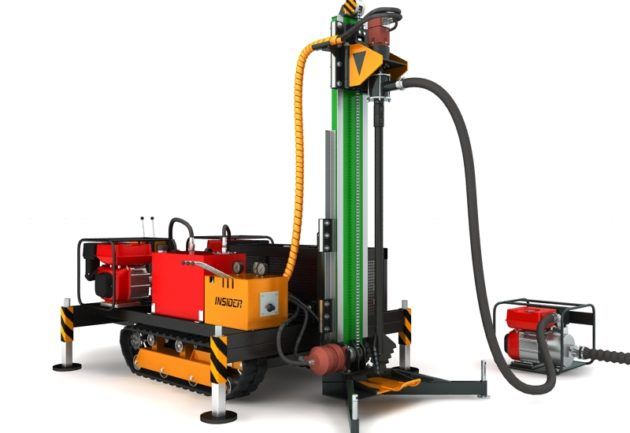
We start drilling important stages of preparation
Do-it-yourself horizontal drilling involves making a puncture using professional equipment. Before you start making a channel under a road or railway, you should prepare for this process. To obtain a drilled hole, it is required to level the platform on which the equipment will be placed.
The size of the site on which the installation will be located must be at least 10x15 m. The site is made exactly in the place of the planned hole under the road. Only after the site of the required size has been prepared, it is possible to transport the appropriate equipment and apparatus.
Beforehand, it is also required to prepare an installation that prepares a bentonite solution. This solution is kneaded by a special vehicle, which must be placed next to the drilling mechanism. The distance between these devices must be at least 10 meters. A solution of bentonite is used to strengthen the walls of the well, as well as to remove earth from the drilled channel.
The preparatory process also includes the following activities:
- Arrangement of special pits at the inlet and outlet of the canal. Excess solution will move into these wells.
- Determine the presence of underground utilities that should not be affected by the drilling rig.
- To study the nature of the soil, on the basis of which a decision will be made to select the optimal route for drilling.
- Set up communication between the foreman and the operator of the equipment.
How the process itself will go depends on the stage of preparation, so this event should be treated with particular importance. During drilling, safety precautions are observed, on which the health and life of workers depends
Method characteristic
The core extracted to the surface - a cylindrical column of material, it is taken for a sample and transported to the top with the help of an auger lift - can tell a lot to subsoil researchers.
The formations are visible in the section; none of the currently existing drilling methods can give such accurate indicators.
The Kola ultra-deep well was drilled in this way. The mark of 12,262 thousand meters was reached - a unique result in exploration drilling.
And the core method is indispensable when drilling wells to search for water, the technology gives a reliable result - 100%. It is worth understanding the intricacies of the technology itself, in the tool for its implementation, to study all the pros and cons.
It is not difficult to use core technology, specialists can work with all types of rocks, up to a depth of 1 thousand meters, when sections of the layers are brought to the surface at a certain frequency.
The concept of a well
According to the method of impact on rocks, mechanical and non-mechanical drilling are distinguished. In mechanical drilling, the drilling tool directly affects the rock, destroying it, and in non-mechanical drilling, the destruction occurs without direct contact with the rock from the source of impact on it. Non-mechanical methods (hydraulic, thermal, electrophysical) are under development and are not currently used for drilling oil and gas wells.
Mechanical drilling methods are divided into percussion and rotary.
During impact drilling, the destruction of rocks is carried out by a chisel suspended on a rope. The drilling tool also includes a shock rod and a rope lock. It is suspended on a rope, which is thrown over a block mounted on a mast (not shown conventionally).
Currently, when drilling oil and gas wells, impact drilling is not used in our country.
Oil and gas wells are constructed using the rotary drilling method. With this method, the rocks are not crushed by impacts, but are destroyed by a rotating bit, which is subjected to an axial load. The torque is transmitted to the bit or from the surface from the rotator (rotor) through the drill string (rotary drilling) or from the downhole motor (turbodrill, electric drill, screw motor) installed directly above the bit.
A turbodrill is a hydraulic turbine driven by a drilling fluid injected into the well. An electric drill is a liquid-proof electric motor, powered by a cable from the surface. A screw motor is a type of downhole hydraulic machine in which a screw mechanism is used to convert the energy of the flushing fluid flow into mechanical energy of rotational motion.
According to the nature of the destruction of rocks at the bottom, continuous and core drilling are distinguished. With continuous drilling, the destruction of rocks is carried out over the entire area of the face. Core drilling provides for the destruction of rocks only along the ring in order to extract a core - a cylindrical sample of rocks along the entire or part of the length of the well. With the help of core sampling, the properties, composition and structure of rocks, as well as the composition and properties of the fluid saturating the rock, are studied.
A well is a mine working of a circular cross section, drilled from the surface of the earth or from an underground working without human access to the face at any angle to the horizon, the diameter of which is much less than its depth. Well drilling is carried out using special drilling equipment
There are vertical, horizontal, inclined wells. The beginning of the well is called its mouth, the bottom - the bottom, the inner side surface - the walls. Well diameters range from 25 mm to 3 m. Wells can have sidetracks (BS), including horizontal (BGS)
By purpose, boreholes are distinguished: mapping, reference, structural, prospecting, exploration, operational, geotechnological and engineering (mining, ventilation, drainage, barrage, explosive, etc.).
A gas well is a well that is drilled into a gas-bearing horizon and is used to extract gas and gas condensate.
An oil well is a well that is drilled into an oil-bearing horizon, or most often an oil-and-gas bearing one, and is used only to extract oil. The well cannot be used for gas production - this is due to the construction of the well itself, and most importantly, the specifics of preparing oil for transportation, gas is cleaned and dried before transportation in accordance with SNiP, TU and other regulatory documents.
Flush drilling
Flushing drilling is started after the casing pipes are pressed into a stable (non-caving) rock.To circulate the flushing flow on drilling rigs of our company, flushing pumps with hydraulic drive (Firms: Speck or Caprari) are installed on KBKB 20/100 with a flow rate of 720 l/min and a lifting height of 83 meters (Speck 50/250), on KBKB 30 /150 with 960 l/min and 132 meters respectively (Caprari MECA 004/80).
For the KBKB 10/2 and KBKB 13 units, flushing pumps are available, for depths up to 50 or 100 meters, on a separate wheeled chassis. These pumps are driven by a separate petrol or diesel engine. The equipment includes a "3" suction hose and a "5" pressure hose.
As a flushing liquid, both pure water and water with additional additives can be used.
Additives are used for additional stabilization of the well walls. Anti-salt or bentonite are used as additives. Our company offers both additives themselves and devices for their mixing and pressing (consists of 3 parts; dimensions 1.5x1.2x0.6 m.) venturi mixer driven by a flushing pump with a flow rate of 500 l/min.
The flushing system consists of 2 containers for better and faster settling of the removed material in the flushing slurry. Uninterrupted operation of the flushing pump directly depends on the quality of cleaning (settlement) of the flushing liquid. The flushing flow enters the first chamber through the "5" outlet hose and is sucked out of the 2nd chamber by the "3" hose. Observe the suction head during operation. It should not be clogged as this will adversely affect the operation of the flush pump.
Cone or blade bits are used as a drilling (cutting) tool when drilling with flushing. When drilling with cone bits, for optimal pressure on the cutting tool, it is recommended to use weighted rods.
The flow of flushing fluid from the well has a speed of 0.3-0.5 m/s.
Photo 4: Cutting pipe shoe
It is important to thoroughly clean the well from the rock at the end of the drilling of each rod. To do this, it is recommended to raise and lower the drilling set 2-3 times on the feed stroke
The rock removal can be controlled using any filter element. Only after the rock removal has stopped, turn off the flushing flow. To do this, it is not necessary to turn off the flush pump. You can only shut off the flushing system using the ball valve on the flushing pump. After mounting the next drill rod, the ball valve opens.
When passing through clay layers, there is a danger of clay swelling under the influence of water and related complications when deepening the geosonde. To prevent swelling of the clay, it is recommended to use magnesia chloride as an additive. This salt prevents the clay from swelling. In addition, the clay rock is carried out not in the form of a suspension, but in the form of small pieces, which simplifies the cleaning of the washing fluid.
In the event of long work pauses, it is recommended to flush the pump with clean water. At negative temperatures, be sure to drain the residual water.
General information about technology
The technique of drilling along a horizontal line consists in the formation of a well by cutting the soil using the corner puncture method. That is, an installation with a working head is introduced into the bowels of the earth in such a way that the surface under which it is planned to conduct a communication channel retains its integrity. The traditional method and technology of horizontal drilling is implemented using a rock cutting tool. This is with an emitter and a bevel. The head performs pilot drilling, and then through the control system the main part of the work is carried out with a change in the parameters of well formation depending on the requirements of the project.
Much of the work is done before the start of drilling. Specialists study the properties and qualities of the soil, the location of functioning communications, etc. Probing of the soil mass with the registration of other underground objects is the most important stage of preparation, after which horizontal directional drilling can begin. Technologies for monitoring possible intersection routes of the existing communication with the project one allow not only to resolve the issue of access to work, but also to determine the optimal tactics and trajectory of well construction.
